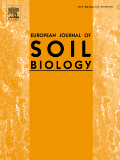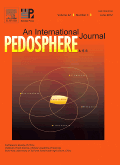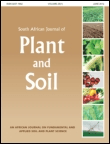
PEDOBIOLOGIA
Scope & Guideline
Fostering Interdisciplinary Dialogue in Soil Research
Introduction
Aims and Scopes
- Soil Microbial Ecology:
Research in this area explores the diversity, structure, and function of microbial communities in various soil types, assessing how these communities respond to environmental changes, management practices, and anthropogenic impacts. - Soil Fauna and Ecosystem Functioning:
This scope investigates the roles of soil macrofauna and mesofauna, such as earthworms and arthropods, in nutrient cycling, soil structure, and overall soil health, highlighting their contributions to ecosystem services. - Impact of Land Use and Management Practices:
Studies focus on how different agricultural practices, land management strategies, and restoration efforts affect soil biota and ecosystem processes, aiming for sustainable practices that enhance soil quality. - Interactions Between Soil Organisms and Plants:
This area examines the symbiotic relationships between soil microorganisms (such as mycorrhizal fungi) and plants, emphasizing their mutual benefits, particularly in nutrient acquisition and stress tolerance. - Responses to Climate Change:
Research addresses how soil biota respond to climate change factors, including temperature and moisture variations, and their implications for soil health and ecosystem resilience.
Trending and Emerging
- Microbial Community Dynamics in Agriculture:
There is an increasing focus on how agricultural practices influence microbial community dynamics, particularly concerning soil health and crop productivity. This trend underscores the importance of soil microbiomes in sustainable agriculture. - Restoration Ecology and Soil Recovery:
Research on the recovery of soil biota and ecosystem functions following land degradation or restoration efforts is gaining traction. This theme emphasizes the role of soil organisms in ecosystem recovery and resilience. - Effects of Invasive Species on Soil Biota:
The impact of invasive plant and animal species on native soil communities and ecosystem processes is becoming a significant area of study, as researchers seek to understand the ecological implications of biological invasions. - Soil Biota and Climate Change Interactions:
Investigations into how soil organisms respond to climate change factors, such as increased temperatures and altered precipitation patterns, are emerging as critical components of soil research, highlighting the adaptive capacities of soil ecosystems. - Functional Traits of Soil Organisms:
There is a growing emphasis on understanding the functional traits of soil organisms, linking their ecological roles to soil processes and overall ecosystem functionality. This trend reflects a more holistic approach to soil ecology.
Declining or Waning
- Traditional Soil Chemistry Studies:
There has been a noticeable decrease in studies focusing exclusively on soil chemistry without considering biological interactions. Recent research is increasingly integrating biological and ecological perspectives. - Static Approaches to Soil Biodiversity:
Research that employs static or single-time-point assessments of soil biodiversity is becoming less prevalent. There is a growing emphasis on dynamic, temporal studies that capture the complexities of soil communities over time. - Generalized Soil Health Indicators:
The use of broad, generalized indicators for soil health is declining in favor of more specific, context-dependent metrics that consider local environmental conditions and management practices.
Similar Journals

EUROPEAN JOURNAL OF SOIL BIOLOGY
Elevating Soil Science to New HeightsThe EUROPEAN JOURNAL OF SOIL BIOLOGY is a leading publication through ELSEVIER FRANCE-EDITIONS SCIENTIFIQUES MEDICALES ELSEVIER, renowned for its rigorous contribution to the fields of soil science, microbiology, and insect science. Established in 1993 and continuing to thrive until 2024, this journal is recognized for its high academic standards, achieving a prestigious Q1 ranking across multiple disciplines including Insect Science, Microbiology, and Soil Science in 2023. With a Scopus rank placing it in the top tiers of relevant categories, the journal serves as a vital platform for disseminating groundbreaking research and advancements in soil biology. Although currently not an open access journal, it offers valuable insights to researchers, professionals, and students, enhancing understanding and fostering innovative solutions for global soil health challenges. The journal's ISSN is 1164-5563 and its E-ISSN is 1778-3615, offering a wealth of knowledge from an esteemed publisher situated in France.

Soil Research
Innovating solutions for soil and environmental challenges.Soil Research, published by CSIRO PUBLISHING, is an esteemed scholarly journal dedicated to advancing the field of soil science, environmental science, and earth-surface processes. With an ISSN of 1838-675X and E-ISSN of 1838-6768, this journal serves as a vital platform for researchers and professionals to disseminate innovative findings and engage with contemporary challenges in soil and environmental management. The journal is recognized for its impactful contributions, as evidenced by its Q2 ranking in 2023 across multiple categories including Earth-Surface Processes, Environmental Science, and Soil Science, reflecting its influence and relevance in these critical academic areas. Operating from its headquarters in Clayton, Victoria, Australia, Soil Research is committed to fostering open access to research, ensuring wider dissemination of knowledge. As it converges toward its future objectives until 2024, the journal aims to provide a forum for diverse perspectives that enhance understanding and stewardship of soil resources, making it an indispensable resource for students, researchers, and industry professionals alike.

PEDOSPHERE
Pioneering Insights into Soil EcosystemsPEDOSPHERE, published by SCIENCE PRESS, is a leading journal in the field of Soil Science, holding a prestigious position in the Q1 category as per the latest evaluations, reflecting its high impact and relevance in the domain. Established in 1996, this journal is committed to advancing our understanding of soil-related processes and their interactions with various environmental components, providing a platform for innovative and high-quality research. With an impressive rank of #13 out of 159 in the Scopus classifications for Agricultural and Biological Sciences, PEDOSPHERE reaches the 92nd percentile, indicating its significance among scholarly publications. Although the journal operates under traditional access options, it remains an essential resource for researchers, professionals, and students keen on exploring the complexities of soil dynamics and sustainability. By bridging interdisciplinary methodologies and fostering collaboration, PEDOSPHERE plays a vital role in addressing global challenges related to soil management, conservation, and ecological balance.

Spanish Journal of Soil Science
Connecting Scientists to Transform Soil ScienceThe Spanish Journal of Soil Science is a prestigious open-access journal published by FRONTIERS MEDIA SA since 2011. Based in Switzerland, this journal serves as a vital platform for disseminating innovative research and applications within the field of soil science. With its commitment to accessibility, the journal enables researchers, professionals, and students from around the globe to contribute to and benefit from its wealth of knowledge. As of 2023, it holds a respectable Q3 category ranking in soil science and is positioned at #88 out of 159 in the Scopus rankings for Agricultural and Biological Sciences. The journal aspires to foster collaboration and communication among soil scientists, encouraging the exploration of contemporary soil issues, sustainable practices, and advancements in technology. Its open-access model ensures that the latest findings are freely available, promoting a broader impact in environmental and ecological studies.

BIOLOGY AND FERTILITY OF SOILS
Unlocking the Secrets of Soil Biology and FertilityBIOLOGY AND FERTILITY OF SOILS, published by Springer, is a leading international journal dedicated to advancing the field of soil science with a focus on the intersection of biological processes and fertility management. With its ISSN 0178-2762 and E-ISSN 1432-0789, this journal serves as a key resource for researchers and professionals alike, reflecting its esteemed status in the community, evidenced by its Q1 rankings in Agronomy and Crop Science, Microbiology, and Soil Science. Covering a broad range of topics from soil health to sustainable agricultural practices, the journal's significant impact factor underscores its critical role in driving innovative research in the domain. While not offering Open Access options, it features rigorous peer-reviewed research that spans decades, converging influential studies from 1985 to 2024. Located in Germany with offices in the United States, the journal maintains a strong international presence, providing insights that enhance the understanding and management of soil ecosystems crucial for sustainable agriculture. Researchers aiming to expand their knowledge on soil biology and fertility will find this journal an invaluable asset.

EURASIAN SOIL SCIENCE
Illuminating the path to better earth and soil practices.EURASIAN SOIL SCIENCE, published by PLEIADES PUBLISHING INC, is a premier journal dedicated to advancing knowledge in the fields of soil science and earth-surface processes. With an ISSN of 1064-2293 and an E-ISSN of 1556-195X, this journal has been a key resource for researchers and professionals from its inception in 1992 and continues to thrive as it converges toward 2024. Situated in the United States, EURASIAN SOIL SCIENCE has achieved notable recognition, attaining a Q2 ranking in both Earth-Surface Processes and Soil Science categories as of 2023. Its Scopus rankings further underscore its importance, with Earth and Planetary Sciences placing it at #81/179 and Agricultural and Biological Sciences ranking it at #80/159. Engaging a global audience, this journal publishes cutting-edge research articles, reviews, and case studies that address critical issues related to soil health, conservation, and management. Though currently not open access, the journal offers valuable insights and fosters collaboration among scientists and practitioners, underscoring its vital role in enhancing the understanding of soil dynamics and sustainability.

Malaysian Journal of Soil Science
Cultivating Knowledge, Enriching Soil Science.The Malaysian Journal of Soil Science, published by the Malaysian Society of Soil Science, serves as a vital platform for disseminating high-quality research in the fields of Agronomy and Crop Science as well as Soil Science. With an ISSN of 1394-7990, this peer-reviewed journal has made significant strides since its establishment in 2009, currently positioned in the Q2 quartile for both categories as of 2023. The journal aims to advance knowledge surrounding soil health and management practices, particularly within the Malaysian context, while also addressing global soil science issues. Despite being based in Malaysia, it welcomes contributions from a diverse range of geographies and viewpoints, enriching the academic discourse. Researchers and practitioners in this field will find a wealth of innovative studies and findings that reflect the current trends and challenges in soil management. Given its current rankings in Scopus, the journal plays a crucial role in shaping the future of soil science, making it indispensable for anyone dedicated to advancing research and practical applications in agricultural and environmental sciences.

South African Journal of Plant and Soil
Championing excellence in plant and soil research.South African Journal of Plant and Soil is an esteemed academic publication dedicated to advancing the fields of Ecology, Plant Science, and Soil Science. Published by TAYLOR & FRANCIS LTD in the United Kingdom, this journal has been a vital resource since its inception in 1984, providing a platform for innovative research and scholarly articles that address critical issues in plant and soil management. With a current impact factor placing it in the Q3 category according to the 2023 rankings, it occupies an influential position within the academic community, especially amongst researchers focused on agricultural and environmental sciences. Although not an open-access journal, it remains accessible to a broad audience through libraries and institutions that recognize its value in facilitating ecologically and environmentally focused discussions. The journal's ongoing commitment to publishing high-quality research ensures that it plays a pivotal role in nurturing knowledge and fostering advancements in sustainable practices across southern Africa and beyond.

CANADIAN JOURNAL OF SOIL SCIENCE
Connecting Research to Real-World Soil SolutionsThe Canadian Journal of Soil Science (ISSN: 0008-4271, E-ISSN: 1918-1841) is a premier publication in the field of soil science, proudly published by Canadian Science Publishing. Established in 1974, this esteemed journal aims to promote high-quality research and insights into the dynamic interactions within soil ecosystems, addressing pressing issues such as soil health, management, and sustainability. With an impressive 2023 category quartile ranking of Q2 in Soil Science and a Scopus ranking placing it in the 52nd percentile, this journal stands out as a key resource for researchers, professionals, and students alike. Although currently not open access, the journal provides valuable content that contributes to advancing the understanding of soil science, an essential discipline for agricultural innovation and environmental stewardship. As we approach its converged years through 2024, the Canadian Journal of Soil Science is poised to continue its pivotal role in disseminating impactful research and fostering a community dedicated to soil science excellence.

Applied and Environmental Soil Science
Uncovering vital insights for sustainable soil and environmental practices.Applied and Environmental Soil Science, an esteemed journal published by HINDAWI LTD, focuses on disseminating high-quality research in the fields of soil science and environmental applications. With an ISSN of 1687-7667 and an E-ISSN of 1687-7675, this open-access journal has been a vital resource for the academic community since its inception in 2009. As of 2023, it holds a commendable position in the Q2 category for both Earth-Surface Processes and Soil Science, highlighting its impact in these crucial disciplines. The journal’s rankings further affirm its significance within the field, being placed 61st in Earth and Planetary Sciences and 58th in Agricultural and Biological Sciences. Researchers and practitioners alike benefit from the collaborative platform it offers for sharing innovative studies essential for sustainable soil management and environmental integrity. With a focus on advancing knowledge and fostering interdisciplinary dialogue, Applied and Environmental Soil Science stands as a crucial pillar for scholars and professionals dedicated to addressing the pressing challenges of soil and environmental health.